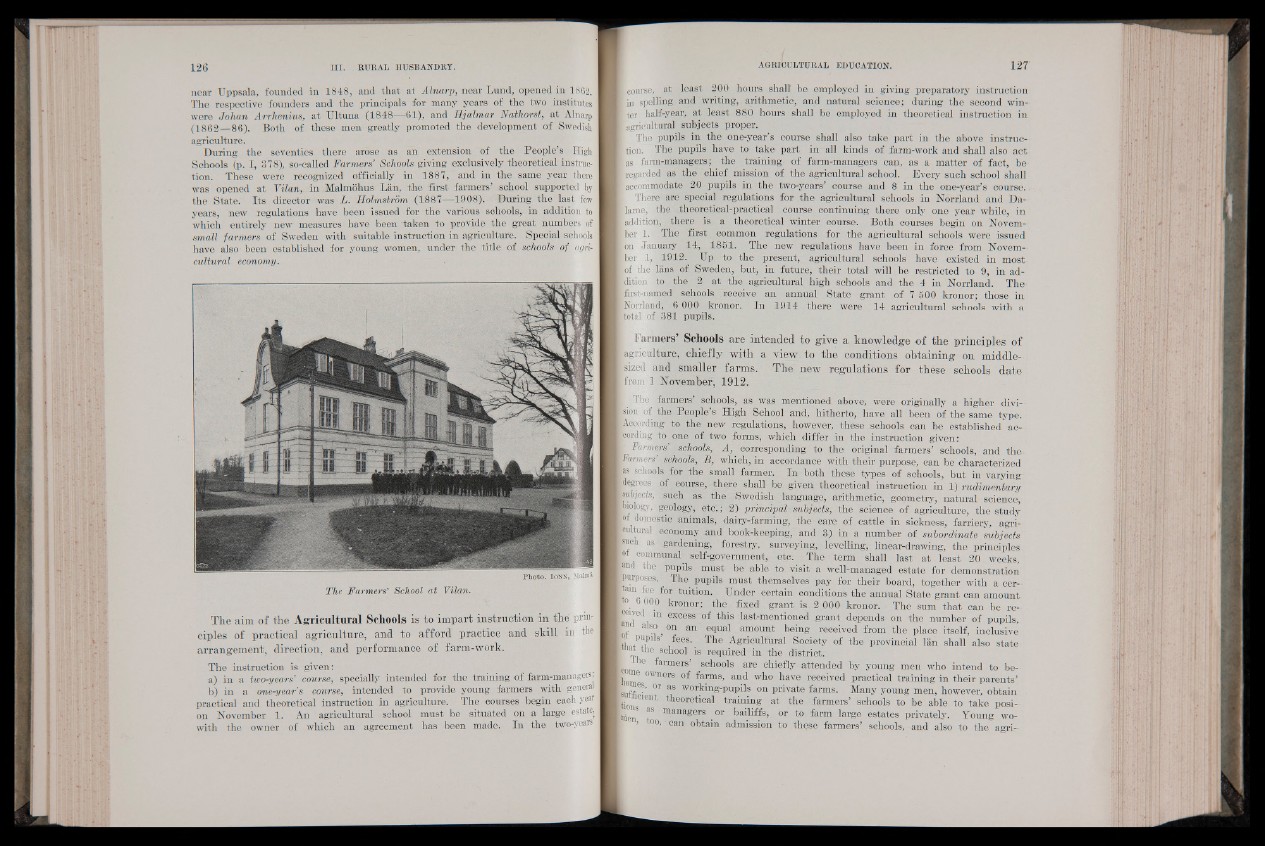
near Uppsala, founded in 1848, and that at Alnarp, near Lund, opened in 1862.
The respective founders and the principals for many years of the two institutes
were Johan Arrhenius, at Ultuna (1848— 61), and Hjalmar Nathorst, at Alnarp
(1 8 6 2—86). Both of these men greatly promoted the development of Swedish
agriculture.
During the seventies there arose as an extension of the People’s High
Schools (p. I, 378), so-called Farmers’ Schools giving exclusively theoretical instruction.
These were recognized officially in 1887, and in the same year there
was opened at Vilan, in Malmohus Lan, the first farmers’ school supported by
the State. Its director was L. Holmstrom (1887—1908). During the last few
years, new regulations have been issued for the various schools, in addition to
which entirely new measures have been taken to provide the great numbers of
small farmers of Sweden with suitable instruction in agriculture. Special schools
have also been established for young women, under the title of schools of agricultural
economy.
Photo. I o n x , Malmö-
The Farmers' School at Vilan.
The aim of the Agricultural Schools is to impart instruction in the'prin-
ciples of practical agriculture, and to afford practice and skill an the
arrangement, direction, and performance of farm-work.
The instruction is given:
a) in a two-years' course, specially intended for the training of farm-managers*
b) in a one-year’s course, intended to provide young farmers with general
practical and theoretical instruction in agriculture. The courses begin each year
on November 1. An agricultural school must be situated on a l a r g e ¡estate,
with the owner of which an agreement has been made. In the two-years
»course, at least 200 hours shall be employed in giving preparatory instruction
I in spelling and writing, arithmetic, and natural science; during the second win-
■ ter half-year, at least 880 hours shall be employed in theoretical instruction in
■ agricultural s u b je c ts propeT.
The pupils in the one-year’s course shall also take part in the above instruc-
■ tion. The pupils have to take part in-a ll kinds of farm-work and shall also act
■ as farm-managers; the training- of farm-managers can, as a matter of fact, be
■regarded as the chief mission of the agricultural school. Every such school shall
■ accommodate 20 pupils in the two-years’ course and 8 in the one-year’s course..
There are special regulations for the agricultural schools in Norrland and D a -
lame, .; the theoretical-practical course continuing there only one year while, in
addition, there is a theoretical winter course. Both courses begin on November
1. The fir s t, common regulations for the agricultural schools were issued
bn January 14, 1851. The new regulations have been in force from November
1, 1912. Up to the present, agricultural schools have existed in most
|of the Ians- of Sweden, but, in future, their total will be restricted to 9, in addition
to the 2 ftt the agricultural high schools and the 4 in Norrland. The
B first-named schools “ receive an annual State grant of 7 500 kronor; those in
■.Norrland, 6 000 kronor. In 1914 there were 14 agricultural schools with a.
■total of 381 pupils.
I armors Schools are intended to give a knowledge of the principles of
agriculture, chiefly with a view to the conditions obtaining on middle-
sized and smaller farms. The new regulations for these schools date
■ from 1 November, 1912.
I The farmers’ schools, as was mentioned above, were originally a higher division
of the People’s High School and,;, hitherto, have all been of the same type,
i&ccordmg to the new regulations, however, these .schools can be established according
to one of two forms, which differ in the instruction given:
t Farmers’ schools, A, corresponding to the original farmers’ schools, and the
i Farmers’ schools, B, which, in accordance with their purpose, can be characterized
as schools for the small farmer.1 In both these types of schools, but in varying-
[degrees oL course, there shall be given theoretical instruction in 1) rudimentary
subjects, such as the Swedish language, arithmetic, geometry, natural science,
[biology, geology, etc.; 2) principal subjects, the science of agriculture, the study
■of domestic animals, dairy-farming, the care of cattle in sickness, farriery, agri-
■cultural economy and book-keeping, and 3) in a number of subordinate subjects
■such as gardening, forestry, surveying, levelling, linear-drawing, the principles.
| r dpnununal^ self-government;- etc. The term shall last at least 20 weeks,
P-u the pupils must be able to visit a well-managed estate for demonstration
[purposes. The pupils must themselves pay for their board, together with a cer-
H ^or tuition. Under certain conditions the annual State grant can amount
U. kronor; the, fixed .grant is 2 000 kronor. The sum that can be re-
|eived in excess of this last-mentioned grant depends on the number of pupils,
fu also on an' equal amount being received from the place itself, inclusive
iL t& iin ,feeS'. The - ^ riouhiural Society of the provincial lan shall also state
I tv, °°1 squired in the district.
ico 6 ^armers" schools are chiefly attended by young men who intend to be-
I ® 6 owners of farms, and who have received practical training in their parents’
f c # P as working-pupils on private farms. Many young men, however, obtain
Itions01 theoretical training at the farmers’ schools to be able to take posi-
ijjjen as 1 managers or bailiffs, or to farm large estates privately. Young wo-
[ ’ J can obtain admission to these farmers’ schools, and also to the agri